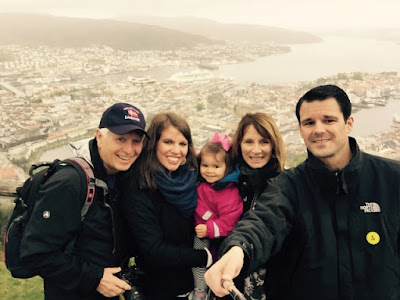
Bergen has the distinction as being the rainiest city in Europe, in fact it rains 270 days a year. While we were not lucky enough to be here on of the 90 days in which they have sunshine, the rain at least held off long enough for us to see this charming city by the sea. Nestled between two mountains, the city is filled with historical wooden buildings, cobblestone streets, a beautiful park and a world-renowned fish market in the harbor.


We had booked a walking tour of Bergen, which was a perfect way to see the city and learn a little about its history.
We began our tour by taking the Fløibanen funicular which takes you to the top of Mt. Fløyen to enjoy a panoramic view.
At 320 meters up above the city you can see for miles around – down to the tiny houses and the boats in Bergen harbor, and out across the mountains and the fjords that twist and turn their way off into the distance.



We encountered our first troll at the top of Mt. Fløyen.



After taking in the breathtaking views, we made our way to the Bryggen Hanseatic Wharf. The Bryggen Hanseatic Wharf is a UNESCO World Heritage site, dating back to 1360 when the Hansas - a German guild of merchants - set up one of their import/export offices on Bryggen and dominated trade for the next 400 years. The Hanseatic League was interested in exporting a product called stockfish. In the rich cold waters around northern Norway, fisherman would catch tons of fish, mainly cod, and haul them back to shore. Then immediately the fish would be gutted, leaving the tails on, and hung by those tails on a large A-shaped open wooden frame called a hjell. For months these fish would dry in the cold windy climate, preserved from rot or insects, until the fish became dry and stiff as boards. After that it was an easy matter to stack the fish in the hold of a ship and bring them to anyone who needed food.
 |
| A wooden replica of a dried cod (stockfish) |

The Hanseatic merchants traded mainly with stockfish from Northern Norway and grain from the Baltic countries.


Walking though the alleys between the houses, it felt as though we were stepping back in time as it still looks like it did in the days of the Hanseatic League.



It's obvious these buildings have been around for a while!
Our next stop was the Hanseatic Museum.

The Hanseatic Museum is situated in one of the old trade houses at Bryggen. The museum has old interiors from the 18th and 19th centuries.Only German merchants were allowed to live at Bryggen during the period of the Hanseatic Office. The Hanseatics were unmarried and had to live in celibacy as long as they lived in the area. The tenements in the Bryggen area each consists of several smaller trade houses, each run by a merchant with a journeyman and apprentices. All of them lived in the house.

Neither light nor heating was allowed in the tenements at Bryggen because of the danger for fire.

Next we visited the fish market located on the harbor. The market not only sells freshly caught fish but fruit, vegetables and other souvenirs.





Before heading back to the boat, we decided to stop at a cafe for lunch.

We had been warned that Norway is very expensive, but we were still shocked when our lunch for four people cost over $150 (but well worth the money :) ).


Belle was happy with her cheeseburger happy meal from McDonald's.

City Park in downtown Bergen
We had a wonderful (and dry) day in Bergen. The rain held off just long enough as it started to sprinkle as we got back on the boat.












No comments:
Post a Comment